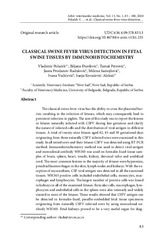Приказ основних података о документу
Classical swine fever virus detection in fetal swine tissues by immunohistochemistry
Detekcija virusa klasične kuge svinja u fetalnim tkivima prasadi primenom imunohistohemijske metode
| dc.creator | Polaček, Vladimir | |
| dc.creator | Đurđević, Biljana | |
| dc.creator | Petrović, Tamaš | |
| dc.creator | Prodanov-Radulović, Jasna | |
| dc.creator | Samojlović, Milena | |
| dc.creator | Vučićević, Ivana | |
| dc.creator | Aleksić-Kovačević, Sanja | |
| dc.date.accessioned | 2020-12-01T11:16:38Z | |
| dc.date.available | 2020-12-01T11:16:38Z | |
| dc.date.issued | 2020 | |
| dc.identifier.issn | 1820-9955 | |
| dc.identifier.uri | https://vet-erinar.vet.bg.ac.rs/handle/123456789/1892 | |
| dc.description.abstract | The classical swine fever virus has the ability to cross the placental barrier, resulting in the infection of fetuses, which may consequently lead to persistent infection in piglets. The aim of this study was to report the lesions in fetuses naturally infected with CSFV during late gestation and clarify the nature of infected cells and the distribution of viral antigen in different tissues. A total of twenty-nine fetuses aged 82, 83 and 95 gestational days originating from three naturally CSFV infected sows were examined in this study. In all tested sows and their fetuses CSFV was detected using RT-PCR method. Immunohistochemistry method was used to detect viral antigen and monoclonal antibody WH303 was used on formalin fixed tissue samples of brain, spleen, heart, tonsils, kidney, ileocecal valve and umbilical cord. The most common lesions in the majority of fetuses were hyperemia, petechial haemorrhages in the skin, lymph nodes and kidneys. With the exception of myocardium, CSF viral antigen was detected in all the examined tissues. WH303 positive cells included endothelial cells, monocytes, macrophages and lymphocytes. The largest number of positive cells was found in kidneys in all of the examined fetuses. Reticular cells, macrophages, lymphocytes and endothelial cells in the spleen were also intensely and widely stained in most of the fetuses. These results showed that CSFV antigen can be detected in formalin-fixed, paraffin-embedded fetal tissue specimens originating from naturally CSFV infected sows by using monoclonal antibody WH303. Fetal kidneys proved to be a very useful organ for diagnosis of the CSF virus. Having that in mind, it is assumed that persistently infected piglets may shed a high amount of viral particles through urine. However, further research is needed to confirm this hypothesis. | en |
| dc.description.abstract | Virus klasične kuge svinja poseduje mogućnost prelaska placentarne barijere, što može dovesti do infekcije fetusa i posledično do nastanka perzistentne infekcije kod prasadi. Cilj ovog istraživanja bio je utvrđivanje lezija koje nastaju kod fetusa prirodno inficiranih virusom klasične kuge svinja tokom kasne faze gestacije, kao i prirodu inficiranih ćelija i distribuciju virusnog antigena u različitim tkivima fetusa. Ukupno je ispitano dvadesetdevet fetusa starosti 82, 83 i 95 dana gestacije, poreklom od tri prirodno inficirane krmače virusom klasične kuge svinja. Prisustvo virusa potvrđeno je kod svih ispitanih krmača i njihovih fetusa upotrebom RT-PCR metode. Za imunohistohemijsku detekciju virusnog antigena u tkivnim isečcima mozga, slezine, srca, tonzila, bubrega, ileoceklane valvule i pupčane vrpce primenjeno je monoklonko antitelo WH303. Kod većine ispitanih fetusa ustanovljena je hiperemija i petehijlna krvavljenja na koži, limfnim čvorovima i bubrezima. Virusni antigen je detektovan u svim ispitanim tkivima fetusa, izuzev tkiva srca. Detektovane WH303 pozitivne ćelije obuhvatale su endotelne ćelije, monocite, makrofage i limfocite. Najveći procenat pozitivnih ćelija na virusni antigen utvrđen je u bubrezima kod svih ispitanih fetusa. Pored toga, veliki broj pozitivnih ćelija dokazan je u retikularnim, limfoidnim i endotelnim ćelijama slezine kod većine fetusa. Rezultati dobijeni u ovom istraživanju pokazuju da se upotrebom monoklonskog antitela WH303 može detektovati antigen virusa klasične kuge svinja u parafinskim isečcima tkiva fetusa prasadi poreklom od prirodno inficiranih krmača. Pored toga, utvrđeno je da su fetalni bubrezi veoma pogodan materijal za dijagnostiku virusa klasične kuge svinja. Na osnovu ovih nalaza postavljena je hipoteza da perzistentno inficirana prasad mogu izlučivati velike količine virusnih čestica putem urina, međutim, potrebna su dodatna istraživanja kako bi se potvrdila ova hipoteza. | sr |
| dc.language | en | |
| dc.publisher | Scientific Veterinary Institute “Novi Sad” | |
| dc.relation | info:eu-repo/grantAgreement/MESTD/Technological Development (TD or TR)/31011/RS// | |
| dc.relation | info:eu-repo/grantAgreement/MESTD/Technological Development (TD or TR)/31084/RS// | |
| dc.rights | openAccess | |
| dc.rights.uri | https://creativecommons.org/licenses/by/4.0/ | |
| dc.source | Archives of Veterinary Medicine | |
| dc.subject | classical swine fever virus | en |
| dc.subject | fetuses | en |
| dc.subject | kidney | en |
| dc.subject | immunohistochemistry | en |
| dc.subject | virus klasične kuge svinja | sr |
| dc.subject | fetusi | sr |
| dc.subject | bubreg | sr |
| dc.subject | imunohistohemija | sr |
| dc.title | Classical swine fever virus detection in fetal swine tissues by immunohistochemistry | en |
| dc.title | Detekcija virusa klasične kuge svinja u fetalnim tkivima prasadi primenom imunohistohemijske metode | sr |
| dc.type | article | en |
| dc.rights.license | BY | |
| dcterms.abstract | Полачек, Владимир; Петровић, Тамаш; Ђурђевић, Биљана; Самојловић, Милена; Вучићевић, Ивана; Проданов-Радуловић, Јасна; Ковачевић-Aлексић, Сања; ДЕТЕКЦИЈA ВИРУСA КЛAСИЧНЕ КУГЕ СВИНЈA У ФЕТAЛНИМ ТКИВИМA ПРAСAДИ ПРИМЕНОМ ИМУНОХИСТОХЕМИЈСКЕ МЕТОДЕ; ДЕТЕКЦИЈA ВИРУСA КЛAСИЧНЕ КУГЕ СВИНЈA У ФЕТAЛНИМ ТКИВИМA ПРAСAДИ ПРИМЕНОМ ИМУНОХИСТОХЕМИЈСКЕ МЕТОДЕ; | |
| dc.citation.volume | 13 | |
| dc.citation.issue | 1 | |
| dc.citation.rank | M24 | |
| dc.identifier.doi | 10.46784/e-avm.v13i1.235 | |
| dc.identifier.fulltext | https://vet-erinar.vet.bg.ac.rs/bitstream/id/5022/Classical_swine_fever_pub_2020.pdf | |
| dc.type.version | publishedVersion |

